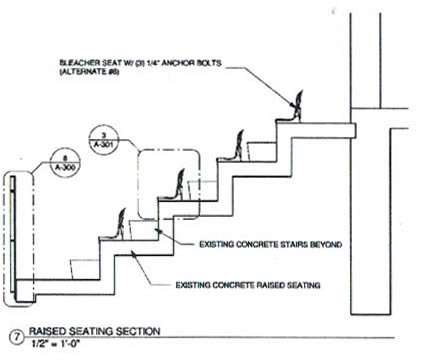What is the seating capacity of your venue with bleachers? Fixed seat-back stadium chairs are easy to count. However, establishing what constitutes a sell-out in a given bleacher section is a dicier proposition.
So, here are some commonly accepted parameters for establishing the capacity of bleachers:
Start with the number of rows of bleachers in the section that you are working with. Next comes the need to establish the length of each bleacher in the section. The section of a football stadium from goal line to goal line is often easy to calculate because the yardage markers help you to establish bleacher length. Each yard equals three feet, so a row of bleacher seats extending from one goal line to the other would be 300 feet long.
However, you won’t have the luxury of simply using the 300 foot figure to calculate the capacity. That’s because exits need to be accounted for. However, a shorter run of seats alongside an exit can be measured and calculated separately. Then, the number of identical sections in the stadium can be counted. Multiple the seating capacity of each section by the number of these sections, and you’ll quickly account for a good portion of the venue’s seating capacity.
However, in the end zone area, it will usually be necessary to actually measure the length of bleacher rows. The same would be true at an occasional basketball arena that uses bleachers.
Personal Space

The key to the entire calculation is how much “personal space,” in inches, is to be allowed per spectator. Companies that sell and install bleachers have sometimes recommended allowing 18-inches per spectator. However, this number may be a bit optimistic in many situations. 24-inches of personal space per fan is perhaps a more appropriate number.
A consideration of the expected mix of fans in a given bleacher section is useful here. For example, the average personal space needed per spectator in a student section may be a little less than that required, on average, in a section slated for use by the general public.
Also, those that manage each venue must determine the relative balance to be struck between fan comfort and stadium revenue. In venues where sellouts are expected to be common, it may be tempting to allow less seating space for each fan. However, the risk here is that uncomfortable fans may be less inclined to spend at concessions. There is also the risk that fans will be alienated enough by being crammed together that they will stay home in the future.
The Formula
The formula to be used in calculating capacity is:
Rows x Length x Inches / Personal Space = Seating Capacity
In abbreviated form, this looks like:
R x L x I / P = C
A Sample Calculation
So, let’s calculate a sample bleacher section. We’ll allow 24-inches of personal space per individual to allow for a decent level of fan comfort.
For this example, there are 20 rows, so R = 20. Each row is 30-feet long, so L = 30. To convert to inches, we have to multiply by 12, so I = 12.
Therefore, the first part of our calculation looks like this: 20 x 30 x 12, which equals 7200. That is, this section of bleachers, consisting of 20 rows with each row 30-feet long, has 7200 linear inches of bleacher space.
Finally, this number is divided by the number of inches allotted to each person. When 7200 is divided by 24, a seating capacity of 300 is established for this sample bleacher section. The calculation looks like this:
20 x 30 x 12 / 24 = 300
If only 18-inches of personal space was to be allotted, the capacity of this section would rise to 400, the result of dividing 7200 by 18. The calculation looks like this:
20 x 30 x 12 / 18 = 400
Personal Space the Key
The key consideration is clearly the personal space allotted to an average attendee. This requires estimating the spectator mix. What percentage will be young children? How many will be mature adults? Answer these questions successfully, and you’ll be well on your way to knowing the true seating capacity at your stadium.







